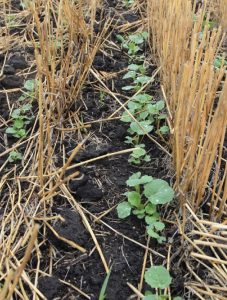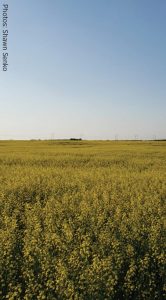Agronomy Insights
Aim for 75 per cent emergence

Why does seed survival matter? Immediate return on your seed investment is one big reason. If you spend $60 per acre on seed, the difference between 50 per cent and 75 per cent emergence could be $15 per acre or more. But that is only the beginning. Yield potential and predictability drops off with a stand below four plants per square foot, which is why the CCC suggests a target of five to eight plants per square foot. Thick, uniform stands are quicker to close canopy, are less likely to need in-season flea beetle control and are less likely to require a second in-crop herbicide application.
Common factors that decrease canola survival are environmental (too dry, too cold, too wet), abiotic (poor seed placement or seed/soil contact, excess seed-placed fertilizer), and biotic (insects and disease).
Some factors like climate are uncontrollable, so focus on the factors under your control to hit 75 per cent emergence:
Practices: Make a plan for seeding that includes setting targets for density and emergence, calibrating the seeding implement regularly, checking seed and fertilizer placement and separation often, seeding 0.5 to 1.0 inch deep into soils 5°C or warmer, seeding in optimum soil moisture conditions when possible, improving record keeping to avoid herbicide carryover issues.
Purchases: Maintain or replace worn equipment, improve residue distribution in the fall, optimize soil P levels long-term and reduce unsafe seed-placed fertilizer applications.
The final step in achieving your stand establishment goals? Assess your own fields and note areas of improvement for next year.
Try new genetics every year
Growing more than one variety each year will improve the resilience
of the farm over time. Use these approaches in combination when
choosing varieties:
1. Always try new varieties with different/new traits to keep genetics moving forward on your farm. When growing only one variety on all acres in any year, a farm’s canola crops have no genetic flexibility to cope with different environmental conditions or changing pest populations. And if yields are lower than expected, the farmer won’t know if it’s a general canola issue (all varieties) or specific to their one variety.
2. Recognize what is holding back yield on each individual field. Review scouting records, and use genetic solutions (and other management changes) to help address the problem. For example, if clubroot is holding back yield, then clubroot resistance (CR) and rotation of CR sources would be important additions to an integrated management approach. If harvest loss is the biggest issue, then maturity and harvestability traits are the priorities.
3. Look beyond yield. In fact, choose the traits you need – blackleg resistance, clubroot resistance, pod-shatter tolerance, days to maturity, lodging, etc. – and make a short list of varieties that provide those traits. Then pick from among that list based on yield potential, price and availability.
Canola Performance Trials 2019 data online
A PDF report of 2019 small plot data was posted at canolaperformancetrials.ca in November. By now, 2019 data is likely available through the online interactive tool, available through the same website.
The 2019 Canola Performance Trials (CPT) program was funded by Alberta Canola, SaskCanola and the Manitoba Canola Growers, along with contributions from the B.C. Grain Producers Association. Haplotech coordinated the trials. The CCC supported the delivery
of the program.
Sclerotinia 2020: Protect your top-end yields
Sclerotinia stem rot is not usually a major issue when yield potential is low, but the disease can be severe when conditions are right for good yields. Fifty bushel per acre canola sounds pretty good, but with good moisture and decent growing conditions in the black soil zone, canola yields can be 70 bu./ac. or more. In good growing conditions, sclerotinia stem rot left uncontrolled can be the difference between 70 and 50.
Read more in the sclerotinia stem rot chapter in the Diseases section at canolaencyclopedia.ca.
The 2019 season provided an important reminder about timing and environment as they relate to sclerotinia infection. Dry conditions right up to flowering meant many growers let their guard down. Then some areas started to get rain. Rain in the two weeks before flower can cause a dramatic increase in disease risk. This moisture also improves yield and extends the flowering period, often making a good case for late-window fungicide applications.
Steps for sclerotinia stem rot management:
1. Use the sclerotinia stem rot checklist, available at canolawatch.org, to determine the risk scenario for sclerotinia stem rot. This is the best tool currently available. Spore measurements (on petals or in the air) can demonstrate the risk level.
2. Use sclerotinia stem rot fungicides in high risk situations for disease development. Apply sclerotinia fungicides at the label rate, label timing, and label water volume.
3. Some other practices can have some effect on risk. Varieties with increased sclerotinia tolerance can help, but stacking with fungicide provides the most benefit. Growers can take steps to reduce the microclimate for the development of sclerotinia stem rot, but these may run counter to steps for good crop competition and yield potential. A clear positive would be to use lodging-resistant canola hybrids. If irrigation is available, reduce water at critical infection time.
Spore detection tools for sclerotinia management
Under ideal warm and moist conditions, it takes around three weeks for the little black sclerotinia sclerotia in the soil to germinate, produce the mushroom-like apothecia and release ascospores. The big question in 2019 was whether the spores were actually present at the time when farmers would normally spray? New tools make spore detection a lot easier. Quantum Genetics and Discovery Seed Labs have new DNA-based petal tests that can provide an answer fairly quickly. The Spornado, which is available through 20/20 Seed Labs, captures spores carried by the wind. Growers and agronomists who want to try Spornado or one of the new DNA petal tests in 2020 can contact the companies over the winter to find out more. For a good discussion with sclerotinia stem rot experts, listen to the ‘sclerotinia’ podcast with Kelly Turkington and Luis Del Rio recorded at canolaPALOOZA 2019. Go to canolawatch.org and click the ‘podcasts’ link under the Tools & Resources tab at the top.

 CC agronomy specialist Shawn Senko took these images from his canola field in 2019.
CC agronomy specialist Shawn Senko took these images from his canola field in 2019.
He didn’t spray fungicide to protect the crop from sclerotinia stem rot, but after it started to rain during flowering, he second guessed himself all year. In the end, disease was low and yield loss was minimal.
The key agronomy message is this: Base the spray decision on the moisture situation before and during flowering. If conditions are right for disease and yield outlook is decent (average or even slightly below average is probably enough), then fungicide can provide a return on investment. Given canola’s ability to respond in a big way to improved growing conditions, a dry start to the season may be irrelevant to the risk scenario.





